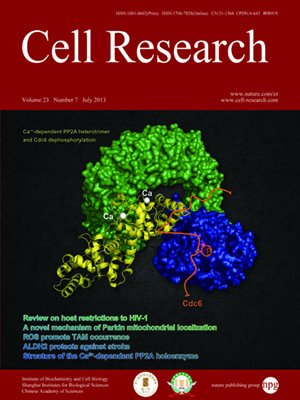
Volume 23, No 7, Jul 2013
ISSN: 1001-0602
EISSN: 1748-7838 2018
impact factor 17.848*
(Clarivate Analytics, 2019)
Volume 23 Issue 7, July 2013: 876-885
REVIEWS
Restrictions to HIV-1 replication in resting CD4+ T lymphocytes
Xiaoyu Pan1, Hanna-Mari Baldauf2, Oliver T Keppler2 and Oliver T Fackler1
1Department of Infectious Diseases, Virology, University Hospital Heidelberg, Im Neuenheimer Feld 324, 69120 Heidelberg, Germany
2Institute of Medical Virology, University of Frankfurt, Paul Ehrlich Str. 40, 60596 Frankfurt, Germany
Correspondence: Oliver T Fackler, Tel: +49-(0)6221-561322; Fax: +49-(0)6221-565003E-mail: oliver.fackler@med.uni-heidelberg.de; Oliver T Keppler, Tel: +49-(0)69-6301-5219; Fax: +49-(0)69-6301-6477(Oliver.Keppler@kgu.de)
CD4+ T lymphocytes represent the main target cell population of human immunodeficiency virus (HIV). In an activated state, CD4+ T cells residing in lymphoid organs are a major reservoir of ongoing HIV-1 replication in infected individuals. In contrast, resting CD4+ T cells are highly resistant to productive HIV-1 infection, yet are massively depleted during disease progression and represent a substantial latent reservoir for the virus in vivo. Barriers preventing replication of HIV-1 in resting CD4+ T cells include a rigid layer of cortical actin and, early after HIV-1 entry, a block that limits reverse transcription of incoming viral RNA genomes. Defining the molecular bases of these restrictions has remained one of the central open questions in HIV research. Recent advances unraveled mechanisms by which HIV-1 bypasses the entry block and established the host cell restriction factor SAMHD1, a deoxynucleoside triphosphate triphosphohydrolase, as a central determinant of the cellular restriction to HIV-1 reverse transcription in resting CD4+ T cells. This review summarizes our current molecular and pathophysiological understanding of the multi-faceted interactions of HIV-1 with resting CD4+ T lymphocytes.
10.1038/cr.2013.74
FULL TEXT | PDF
Browse 2921


